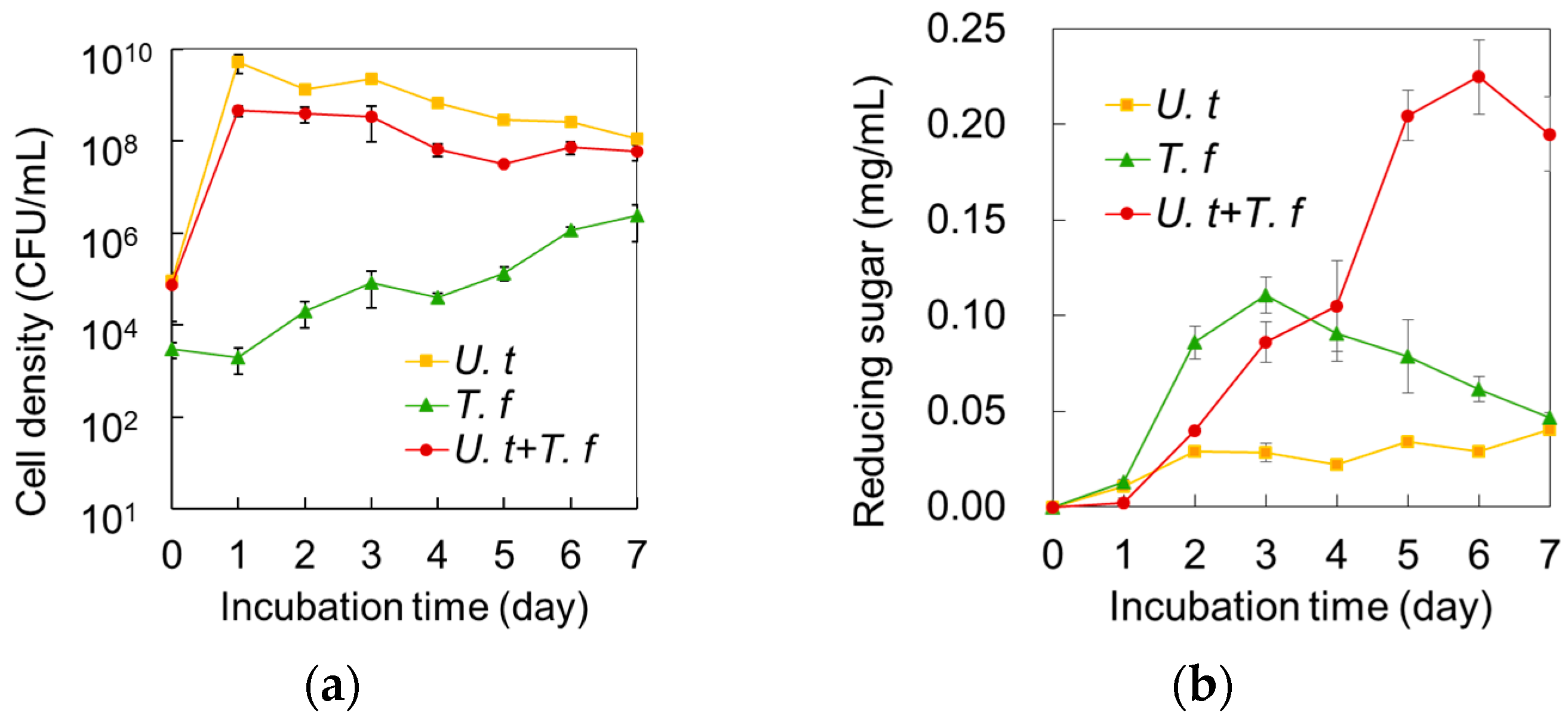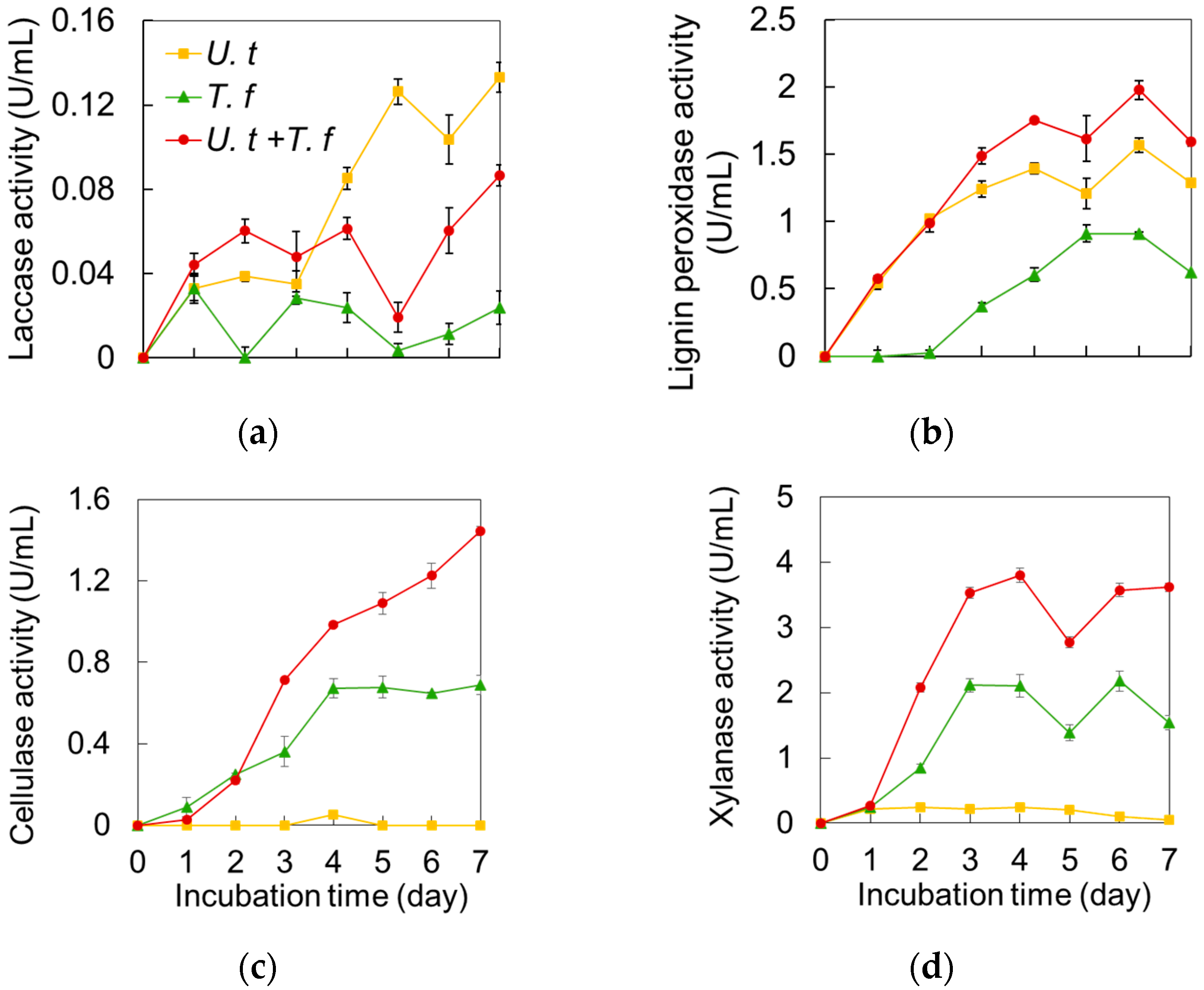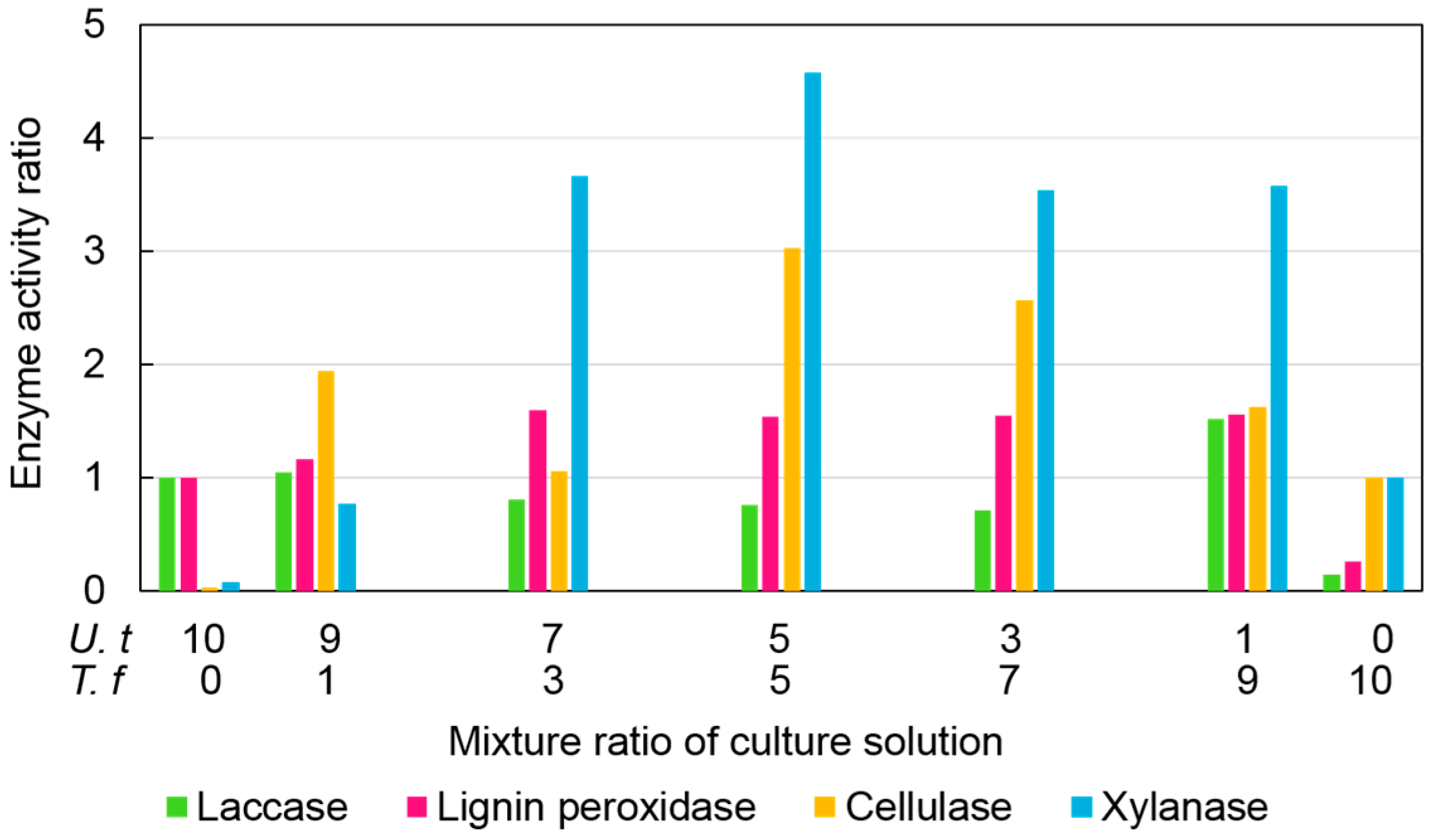Decomposition of Rice Chaff Using a Cocultivation System of Thermobifida fusca and Ureibacillus thermosphaericus †
Abstract
:1. Introduction
2. Materials and Methods
3. Results and Discussion
3.1. Cell Density
3.2. Concentration of Reducing Sugar
3.3. Enzymatic Activities
3.4. Influence of the Mixture Ratio of the Coculture
4. Conclusions
Author Contributions
Conflicts of Interest
References
- Wongwilaiwalin, S.; Laothanachareon, T.; Mhuantong, W.; Tangphatsornruang, S.; Eurwilaichitr, L.; Igarashi, Y.; Champreda, V. Comparative metagenomic analysis of microcosm structures and lignocellulolytic enzyme systems of symbiotic biomass-degrading consortia. Appl. Microbiol. Biotechnol. 2013, 97, 8941–8954. [Google Scholar] [CrossRef] [PubMed]
- Belenguer, A.; Duncan, S.H.; Calder, A.G.; Holtrop, G.; Louis, P.; Lobley, G.E.; Flint, H.J. Two Routes of Metabolic Cross-Feeding between Bifidobacterium adolescentis and Butyrate-Producing Anaerobes from the Human Gut. Appl. Environ. Microbiol. 2006, 72, 3593–3599. [Google Scholar] [CrossRef] [PubMed]
- Geib, S.M.; Filley, T.R.; Hatcher, P.G.; Hoover, K.; Carlson, J.E.; Jimenez-Gasco, M.M.; Nakagawa-Izumi, A.; Sleoghter, R.L.; Tien, M. Lignin degradation in wood-feeding insects. Proc. Natl. Acad. Sci. USA. 2008, 105, 12932–12937. [Google Scholar] [CrossRef] [PubMed]
- Shioya, S. Optimization of bioprocess systems. Seibutsu-Kogaku 2010, 88, 2–10. (In Japanese) [Google Scholar]
- Kurosawa, N.; Itoh, Y.H.; Iwai, T.; Sugai, A.; Uda, I.; Kimura, N.; Horiuchi, T.; Itoh, T. Sulfurisphaera ohwakuensis gen. nov., sp. nov., a novel extremely thermophilic acidophile of the order Sulfolobales. Int. J. Syst. Bacteriol. 1998, 48, 451–456. [Google Scholar] [CrossRef] [PubMed]
- Miller, G.L. Use of dinitrosalicylic acid regent for determination of reducing sugar. Anal. Chem. 1959, 31, 426–428. [Google Scholar] [CrossRef]
- Schlosser, D.; Grey, R.; Fritsche, W. Patterns of ligninolytic enzymes in Trametes versicolor. Distribution of extra- and intercellular enzyme activities during cultivation on glucose, wheat straw and beech wood. Appl. Microbiol. Biotech. 1997, 47, 412–418. [Google Scholar] [CrossRef]
- Saha, B.C.; Iten, L.B.; Cotta, M.A.; Wu, Y.V. Dilute acid pretreatment, enzymatic saccharification and fermentation of wheat straw to ethanol. Process Biochem. 2005, 40, 3693–3700. [Google Scholar] [CrossRef]



Publisher’s Note: MDPI stays neutral with regard to jurisdictional claims in published maps and institutional affiliations. |
© 2021 by the authors. Licensee MDPI, Basel, Switzerland. This article is an open access article distributed under the terms and conditions of the Creative Commons Attribution (CC BY) license (http://creativecommons.org/licenses/by/4.0/).
Share and Cite
Nakamura, S.; Kurosawa, N. Decomposition of Rice Chaff Using a Cocultivation System of Thermobifida fusca and Ureibacillus thermosphaericus. Proceedings 2020, 66, 31. https://doi.org/10.3390/proceedings2020066031
Nakamura S, Kurosawa N. Decomposition of Rice Chaff Using a Cocultivation System of Thermobifida fusca and Ureibacillus thermosphaericus. Proceedings. 2020; 66(1):31. https://doi.org/10.3390/proceedings2020066031
Chicago/Turabian StyleNakamura, Sachiko, and Norio Kurosawa. 2020. "Decomposition of Rice Chaff Using a Cocultivation System of Thermobifida fusca and Ureibacillus thermosphaericus" Proceedings 66, no. 1: 31. https://doi.org/10.3390/proceedings2020066031
APA StyleNakamura, S., & Kurosawa, N. (2020). Decomposition of Rice Chaff Using a Cocultivation System of Thermobifida fusca and Ureibacillus thermosphaericus. Proceedings, 66(1), 31. https://doi.org/10.3390/proceedings2020066031




